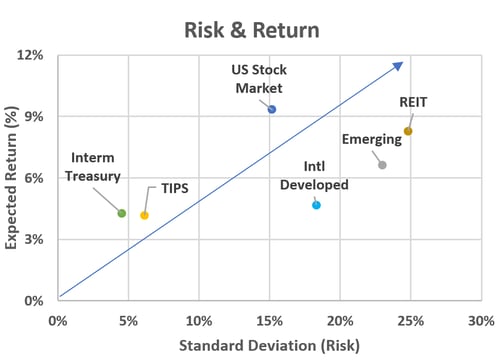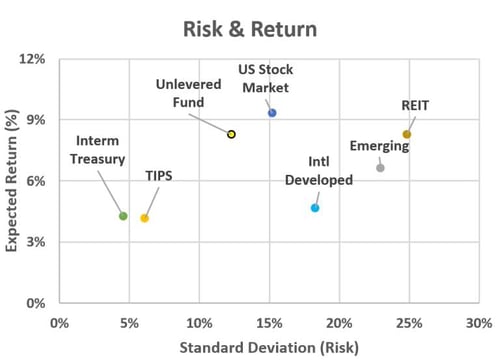A question on the mind of anyone within a few years of retirement is, how can you ensure that you have enough money saved to afford a comfortable retirement? The standard advocated by some experts is a nest egg of at least $1 million, while others recommend saving an amount equal to 10 to 12 times your current income.
But a more accurate response that applies to most retirees is, “It depends.”
It depends on your current health, planned retirement age, where you live, and what activities you plan to take part in during your retirement years. In addition, it depends on the investment choices you make. How should you invest for retirement? While there is no single answer that covers everyone, there are some things that everyone should know, and questions and options that should be considered as you approach retirement age.

Do you know the risk of your retirement investments?
The typical person likely doesn’t give much thought to the role that risk plays in their investments. In fact, many don’t give a moment’s glance to the paycheck deduction going to their retirement account.
However, risk is perhaps the key variable when it comes to investing. The risk of your investments will play a role in when you can afford to retire, as well as how comfortable you will be when you walk out your employer’s door for the last time.
What is risk?
When it comes to an investment, ‘risk’ is a product of two factors: (1) the likelihood that your investment will increase or decrease in value, and (2) how drastically it could increase or decrease in value. To determine risk, we look at several factors that are specific to that investment.
For instance, consider an investor deciding to invest between two different companies. The first company is in the S&P 500 Index, and has been a mainstay of the American stock market for many decades. The second is a young tech company that is generating a buzz, but which hasn’t yet brought a profitable product to market.
If you were to buy stock in one of these two companies, you would have to consider:
- The first company has less risk attached to it. It will likely weather anything short of another Great Depression, and even then it would likely survive.
- The second company has more risk attached to it. It could potentially turn out to be the next Google or Amazon—hence the excitement—or it may never generate a profit.
The greater the risk that an investment carries, the greater potential return or loss it may generate.
Let us consider our two hypothetical stocks.
Because the first company is such a stable workhorse, we know the downside is minimal. Even if the company has a couple bad years, we likely won’t lose the majority of our investment, and if we hold the stock long enough, we could achieve modest returns. But because our potential risk is moderate, our potential rewards are similarly moderate. For example, since 2000, Coca-Cola’s stock has been relatively stable, moving no lower than roughly $19 a share (2003), and no higher than about $50 a share (2018). Someone who invested at the low point in 2003 would have realized a 6% per year return on their investment through the end of 2018.
This illustrates how anyone investing in Coca-Cola or another ultra-stable company could be secure in the knowledge that while the value of their investment will vary, they will almost certainly not see their investment go to zero, and have a good chance of realizing profits. Consequently, this means their investment probably won’t increase significantly in the short term. An investor who perfectly timed when to buy would have generated an annual return of 11%, which while being a handsome return, relative to the rest of the S&P 500 Index, it’s rather consistent with the rest of the market.
The second company is more of an unknown. Many young tech companies end up failing because they never find a way to generate a profit, or they are hit by unexpected legal or ethical scandals, as happened with blood test company Theranos—earlier this year, Rupert Murdoch sold off his $125 million investment stake in the company for $1. Consequently, the very high risk of this hypothetical tech stock is offset by potentially astronomical returns. This may very well be the chance to get in on the ground floor of the next tech titan–those who bought Amazon at $10 a share in late 2001 are enjoying returns of almost 120x less than 15 years later. There is a high risk of failure, but success could deliver a far greater payoff than would be possible investing in any tried and true company.
Successful investment requires balancing the risks of your various investments.
Risk is a fact of life. Investors who are investing long-term—whether that be through a 401(k), owning a rental home, or some other form of investment—should expect to see multiple economic downturns during the lifetimes of their investments. This fact, along with an investor’s individual tolerance for risk and when they expect to need access to their funds should all factor into how they allocate their portfolio.
For instance, a common rule of thumb is to take the percentage of your total portfolio equal to your age and invest it into fixed income investments—individual bonds, bond ETFs, money market funds, etc.—and the rest into equities, such as individual stocks or equity ETFs. Thus, someone who is 30 years old should invest 30% into fixed income and 70% into equities, while someone who is 55 should invest 55% in fixed income and 45% in equities. But someone who is more risk averse or who anticipates that they will need to retire earlier due to a health issue should allocate more conservatively, whereas someone with a greater tolerance for risk may lean even more towards equities.
Note that the age-based metric for investment balancing described above implies a truth that many investors overlook: it is important to rebalance your investments every so often. As you age, you will generally want to decrease the average risk of your portfolio. But there may also be times where it makes sense to increase your risk tolerance, such as early on in your investing career or if you have other steady income to the extent you will not be impacted by the loss of your investment.
Optimizing your investment portfolio is easy, especially if you take the “lazy portfolio” approach.
Too many people don’t look at their investments at all, in the belief that being hands-on would require specialized skills and knowledge that they lack. This is a problem, as investment portfolios do require a certain amount of adjustment from time to time in order to maximize performance, and also to hedge against risk.
But managing your investment portfolio doesn’t have to be difficult. You just need to have a basic understanding of the different types of assets and their relative risks and behaviors. You can further reduce the amount of work you have to do by taking the “lazy portfolio” approach.
David Swensen is renowned for his work as the investment manager of Yale University’s Endowment Fund, and his book Unconventional Success. But he may be most famous for his “lazy portfolio,” which was designed to allow the average investor to manage their own investments. This portfolio is not only known for its simplicity and diversification, but for its enduring performance as well.
Swensen’s suggested allocation looks like this:
| Asset Class | Allocation |
| US Stock Market | 30% |
| REIT (Real Estate Investment Trusts) | 20% |
| Intl Developed | 15% |
| Emerging | 5% |
| TIPS (Treasury Inflation Protected) | 15% |
| Intermediate Term Treasury | 15% |
The lazy portfolio is a heavy dose of domestic and international equities, a sizeable allocation of real estate, and finally the most secure forms of fixed income—two types of treasuries. Since 1970, this portfolio allocation has had an average return of 6.4%, with a standard deviation of 11.3%. These two figures are what most investors tend to focus on: “How much will I make, and how risky is my investment?” Standard deviation is a data-driven way to understand the underlying risk and volatility associated with an investment. If an investment has a high standard deviation, then it is likely a riskier asset and the investor should expect a higher return for the extra risk they are taking. Let’s look at the risk and return profile for the lazy portfolio:
 Trade-offs: Risk vs. Return
Trade-offs: Risk vs. Return
In the “Risk & Return” chart, you can see that equities exhibit higher return expectations, but also come with a higher amount of risk, whereas fixed income (Treasury and TIPS) investments have lower risks and lower returns. An investor looking to avoid risk would likely allocate more of their portfolio away from equities and towards more fixed income, but would have to accept a lower expected return for their portfolio. The arrow on the chart depicts this relationship between risk and return. This line, typically referred to as the Security Market Line, shows that as risk grows, so should return.
Diversification
Looking at the chart again, some investors may ask, “Why should I consider some of these asset classes such as real estate investment trusts (REITs) or international equities? The return for the risk does not look very favorable relative to US equities.”
The reason Swensen includes these asset classes in his recommendation is because they do not all move in the same direction at the same time. They are hedges against one another. In other words, the recommended asset classes are not strongly correlated with one another. This is best visualized by looking at the correlation table below.

Swensen’s portfolio illustrates that diversification is a key factor in generating a consistent return. There needs to be a mix of assets that will not always move in the same direction. For example, the three equity assets (US, international developed, and emerging) are all strongly correlated (with 80% to 88% correlated). This means that if the value of one of those equities increased, the other two would increase 80% to 88% of the time. The same would apply for the downside.
While equities are positively correlated to each other, equities are not as strongly correlated to REITs, with only a 50% to 60% probability of moving in the same direction. In some cases, equities can even be inversely correlated, or show zero correlation, such as with TIPS and intermediate treasuries. If an investor were to have their entire portfolio allocated to just equities, the positive years would be very strong, but the down years would be difficult to bear.
REITs & Leverage
Swensen’s advocacy for REITs is embraced by the Boglehead community, which advocates for a low-touch, low-cost index portfolios approach. Many registered investment advisors (RIAs) see REITs as an easy way to allocate their clients’ portfolios into real estate without having to buy an individual property that the investor or advisor would then have to manage. However, one key aspect often overlooked by the RIA community is that most REITs use significant amounts of leverage. Leverage behaves like a double-edged sword, amplifying both positive returns and negative ones. This helps explain why REITs are so volatile, as seen on the Risk & Return chart. Historically, REITs exhibit an expected yield of about 8%, but with significantly higher volatility.
There are options available outside of REITs that can generate similar returns, along with the reduced correlations, but without the volatility. For example, a well-managed mortgage fund, which invests in a portfolio of senior mortgages, could be expected to produce an expected return of 8% in today’s market without relying on any form of leverage. The lack of leverage would mean that the fund would have to be operated efficiently to keep investor funds actively invested to avoid decreasing investor returns due to idle cash. However, investors can rest assured that their returns will be subject to less volatility, provided the investor can withstand the reduced liquidity.
Given where the REIT is located on the Risk & Return chart, it can be argued that REITs do not make effective use of their leverage. A rational investor would expect that the riskier an asset is, the higher the expected return. For example, the US stock market appears to be effectively using its leverage with a higher expected return than treasuries, but with a commensurate amount of increased risk. A way to express this tradeoff between risk and return is commonly described as the Sharpe Ratio, which is defined as:

Where:
- rx is the expected return on the investment
- Rf is the risk-free rate of return
- σx is the standard deviation of the investment
Applying this formula to REITs, we can see that the asset class has a low Sharpe Ratio relative to US Stocks and Treasuries. If it were not for its unique correlation characteristics, many investors would likely choose to disinvest altogether and focus on just Treasuries and US Stocks. This is actually an approach popularized by the Boglehead community in such variants of the “Lazy Portfolio” as the “Two Asset Portfolio” and “Three Asset Portfolio.”
 Optimizing Risk-Adjusted Return
Optimizing Risk-Adjusted Return
Let’s look back at our chart that examines the tradeoffs of risk versus return. Comparing the typical REIT with a mortgage fund (“unlevered fund”), the two asset classes exhibit similar expected returns, but considerably different risk profiles. The mortgage fund’s Sharpe Ratio is much more efficient than that of REITs, while also maintaining the lack of correlation to other asset classes.
Reducing an investor’s risk in just one asset class can have significant benefits for a diversified portfolio. Substituting a typical REIT with our hypothetical mortgage fund, the typical Swensen Portfolio can now yield the same expected yield, but with considerably less risk. Looking at the chart, the investor can see that the both the mortgage fund and a REIT investment have an expected return of 8%, but a REIT has double the risk of the fund due to the aforementioned use of leverage. When the Lazy Portfolio swaps these two assets, the overall portfolio’s risk profile decreases by almost 20%, while still maintaining a well-diversified portfolio with relatively low correlation.
What should you do with your 401(k) when you retire?
A common concern for retirees is what to do with their employer-sponsored 401(k) retirement accounts when they retire. Technically, you can choose to simply leave your 401(k) alone, and take the minimum required distribution if you’re over the age of 70 ½. However, once you are no longer employed by the company sponsoring your 401(k), you can no longer contribute to it, which is a serious limitation if you have other sources of income you wish to invest into it.
Government bonds are no longer the ideal retirement investment they once were.
It’s advisable at this point to shift your investments to options which are more stable and less risky. In the early years of 401(k) plans, it wasn’t unusual for retirees to put their money into ultra-secure government bonds. This was a worthwhile investment, as 30 to 40 years ago bonds commonly featured interest rates of 8 to 12%.
But nowadays, the best interest rate you can hope to get on a treasury bond is about 2%, which scarcely outpaces the current inflation rate. Given how expensive retirement is these days, especially for those who expect to eventually enter a retirement home or assisted living home, merely keeping up with inflation simply won’t cut it. But putting money into investments with greater growth potential, but which also have far greater volatility, simply isn’t an option. So what to do?
Rolling over into a self-directed IRA offers the opportunity to invest in high yield real estate deeds.
Many retirees roll their 401(k) accounts into an IRA or Roth IRA, depending on their particular needs. However, that still leaves the question of what to do with the money in your IRA. Many retirees are having great success rolling their 401(k)s into self-directed IRAs, and then using that capital to invest alternative options, such as real estate.
In recent years, real estate-backed options have been a “best of both worlds” type choice, as they can offer far higher yields than traditional investment choices, without the volatility inherent to most Wall Street investments. However, simply investing in one or two pieces of property does expose retirees to downturns in the market, which can be devastating for those who have short- to mid-term outlooks for their investments.
This is why we recommend diversified investment funds that specialize in trust deed investments. We have seen a great deal of success with our own real estate fund, The Socotra Fund. It provides non-leveraged, low loan-to-value (LTV) loans across many properties. Rather than relying on the value of a single piece of property, a real estate fund offers stability, with the bonus of providing a consistent monthly income that allows you to quickly take advantage of the interest on your investment.
Does it make sense to invest in real estate for retirement?
Given that we have real estate-based investment funds, it’s easy for us to say that real estate investment is a great idea. But it’s another thing entirely to explain why it’s a logical choice. Here’s our perspective.
As we noted above, investors need to understand the risks of their investment choices. One of the most significant types of risk is volatility. Any investor who watched stocks melt down during the 2008 market crash understands the dangers of volatility.
Although volatility cannot be eliminated entirely, there are ways to minimize it. A key strategy for managing risk is to invest for the long term. Another essential strategy is portfolio diversification, which reduces the impact of volatility by spreading risk across many assets. Diversified portfolios should have allocations among all the major asset categories (stocks, bonds and alternative assets), as well as diversification within each category.
A key means of diversification is real estate. But you don’t have to deal with the responsibilities of owning real estate in order to invest in it.
Real estate-backed mortgage pool funds offer significant diversification benefits and are excellent for hedging against inflation.
Because of low correlations with stocks and bonds, mortgage pool funds can be invaluable tools for diversifying a portfolio. This characteristic of mortgage pool funds was evidenced during the 2008 crash when stocks lost nearly 40% of their value and bond returns dropped to 5%, but many mortgage pool funds continued to deliver 8-10% returns to investors.
A second major investment risk and one that may increase exponentially over time is inflation, or the loss in purchasing power that occurs as consumer prices inflate. Mortgage pool funds are real estate-backed fixed income instruments and may help reduce an investor’s exposure to inflation risk. Historically, real estate income has beaten inflation 71% of the time.
Mortgage pool funds offer a convenient way to leverage the inflation hedging benefits of real estate without assuming the risks that are associated with direct property ownership such as poor liquidity. Other benefits of owning real estate-backed investments include the asset’s stable intrinsic value due to its role in the economy on multiple levels.
To feel secure in retirement, most investors want to hold assets that generate steady income. With the exception of dividend stocks, which are trading at a premium right now, the stock market cannot be relied upon to deliver consistent income. Over the longer-term, stocks have generally been solid performers, but there have also been extended periods when stocks lost value. An example is the period between 1998 and 2008, when US stocks actually declined by 0.6%. This is a mild loss, but a loss all the same. Meanwhile, bonds generate predictable income, but the Fed’s low interest rate policies of recent years have reduced bond yields to miniscule levels.
This brings us to two other key benefits of investing in mortgage pools.
Mortgage pools deliver a steady monthly income.
Mortgage pool funds can help investors feel secure in retirement by delivering dependable monthly income at yields superior to most bonds and with minimal downside risk. Annualized returns vary by mortgage pool fund depending on the markets served, the fund’s investment timeframe and risk profile and other fund-specific factors. Mortgage pool fund investors have the option of accepting monthly payouts or expanding their stake in the fund by reinvesting distributions in more shares, which fuels exponential growth through compounding.
Many mortgage pools pay distributions on a monthly basis, and well-managed mortgage pool funds typically generate yields that handily beat most stocks and bonds. At present, the average mortgage pool fund investor can expect to be earning high single-digit/low double-digit yields from their investment.
The risk of loss is minimal.
In addition to the risk mitigation that comes from diversification, mortgage pool funds have inherent advantages that further reduce risk. Each loan is secured by a physical asset, real estate, which retains value regardless of volatile price swings in the stock and bond markets. Mortgage pool funds provide an added layer of safety by maintaining a sizable spread between the loan amount and the value of the property that secures the loan.
Most mortgage pool funds limit loan amounts to less than 70% of a property’s collateral value. More conservative mortgage pool funds, such as the Socotra Fund, limit loan amounts to 60 percent or less of the property’s resale value. By maintaining this financial cushion, mortgage pool funds are able to recoup all of their investment if the borrower defaults and the property must be monetized through a foreclosure sale.


